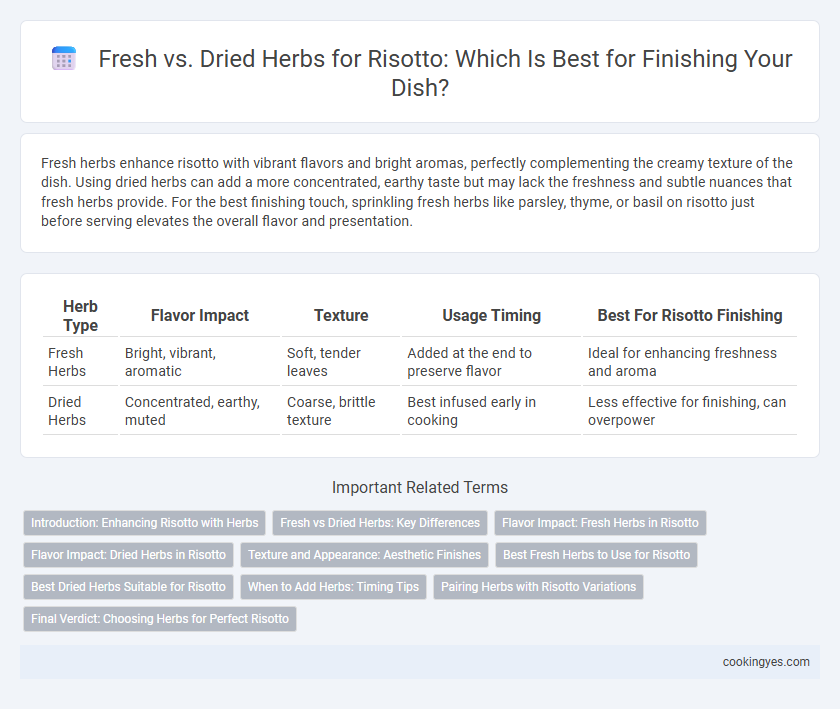Fresh herbs enhance risotto with vibrant flavors and bright aromas, perfectly complementing the creamy texture of the dish. Using dried herbs can add a more concentrated, earthy taste but may lack the freshness and subtle nuances that fresh herbs provide. For the best finishing touch, sprinkling fresh herbs like parsley, thyme, or basil on risotto just before serving elevates the overall flavor and presentation.
Table of Comparison
| Herb Type | Flavor Impact | Texture | Usage Timing | Best For Risotto Finishing |
|---|---|---|---|---|
| Fresh Herbs | Bright, vibrant, aromatic | Soft, tender leaves | Added at the end to preserve flavor | Ideal for enhancing freshness and aroma |
| Dried Herbs | Concentrated, earthy, muted | Coarse, brittle texture | Best infused early in cooking | Less effective for finishing, can overpower |
Introduction: Enhancing Risotto with Herbs
Fresh herbs provide vibrant aroma and bright flavors that elevate risotto's creamy texture, with parsley, thyme, and basil commonly used for finishing. Dried herbs offer concentrated and intense taste but require careful timing to avoid overpowering the dish, often added earlier in cooking. Choosing between fresh and dried herbs depends on desired flavor intensity and presentation, balancing freshness with deeper herbaceous notes.
Fresh vs Dried Herbs: Key Differences
Fresh herbs provide vibrant, aromatic flavors and a bright color that enhance risotto's texture and visual appeal, while dried herbs offer a more concentrated, earthier taste useful in slow-cooked phases. The moisture content in fresh herbs can balance the creamy consistency of risotto, whereas dried herbs release their strong essence gradually, intensifying the dish's complexity. Choosing between fresh and dried herbs depends on the desired flavor intensity and the cooking stage at which they are added to the risotto.
Flavor Impact: Fresh Herbs in Risotto
Fresh herbs such as parsley, basil, and chives deliver vibrant and aromatic flavors that elevate the creamy texture of risotto, creating a lively and complex taste profile. Their essential oils provide a bright, fresh burst that dried herbs often lack, enhancing the overall sensory experience. Incorporating fresh herbs at the finishing stage preserves their delicate flavors, ensuring the risotto finishes with a refreshing and fragrant touch.
Flavor Impact: Dried Herbs in Risotto
Dried herbs in risotto contribute a concentrated and intense flavor profile, enhancing the dish with robust herbal notes that can withstand the creamy texture and subtle taste of the rice. Their potency allows for a longer cooking process without flavor loss, infusing the dish deeply during simmering and finishing. Using dried herbs like thyme, oregano, or rosemary can elevate the savory depth while maintaining the classic consistency of a well-prepared risotto.
Texture and Appearance: Aesthetic Finishes
Fresh herbs provide vibrant color and a tender texture, enhancing the visual appeal and delicate mouthfeel of risotto finishes. Dried herbs offer a more muted hue and slightly coarse texture, often dispersing evenly but lacking the fresh, crisp aesthetic. Using fresh herbs preserves the dish's bright, inviting appearance with a refined, soft finish.
Best Fresh Herbs to Use for Risotto
Fresh herbs like parsley, chives, thyme, and basil are ideal for finishing risotto, offering vibrant flavor and aroma that complement the creamy texture. These herbs retain their bright color and delicate taste better than dried options, enhancing the dish without overpowering it. Adding fresh herbs at the end ensures a burst of freshness and elevates the overall sensory experience of the risotto.
Best Dried Herbs Suitable for Risotto
Dried herbs such as thyme, oregano, and rosemary are among the best choices for finishing risotto due to their robust flavors that concentrate during cooking. These herbs withstand the gentle heat of risotto, releasing aromatic oils slowly and enhancing the dish's earthy profile without overpowering the creamy texture. Using dried basil or sage can also add depth, but it's important to crush them slightly before stirring in to maximize their flavor infusion.
When to Add Herbs: Timing Tips
Add fresh herbs like parsley or basil at the end of cooking risotto to preserve their vibrant flavor and aroma. Dried herbs require longer cooking times and should be added earlier in the process to fully release their essential oils. Adjusting the timing of herb addition ensures balanced flavor integration and enhances the overall risotto experience.
Pairing Herbs with Risotto Variations
Fresh herbs like parsley, chives, and basil brighten creamy risotto dishes such as mushroom or seafood risotto by adding vibrant, aromatic notes. Dried herbs like thyme or oregano work well in heartier, slow-cooked risottos featuring robust ingredients like sausage or tomatoes, imparting concentrated, earthy flavors. Selecting herbs according to risotto variations enhances the dish's depth and balances creamy textures with complementary herbal aromas.
Final Verdict: Choosing Herbs for Perfect Risotto
Fresh herbs like basil, parsley, and chives impart vibrant, aromatic flavors essential for the finishing touch of risotto, enhancing its creamy texture without overpowering. Dried herbs, while convenient, often lack the brightness and can introduce bitterness if added too late in cooking. For perfect risotto, fresh herbs are the optimal choice, ensuring a delicate balance that elevates the dish's freshness and complexity.
Fresh vs dried herbs for risotto finishing Infographic

 cookingyes.com
cookingyes.com